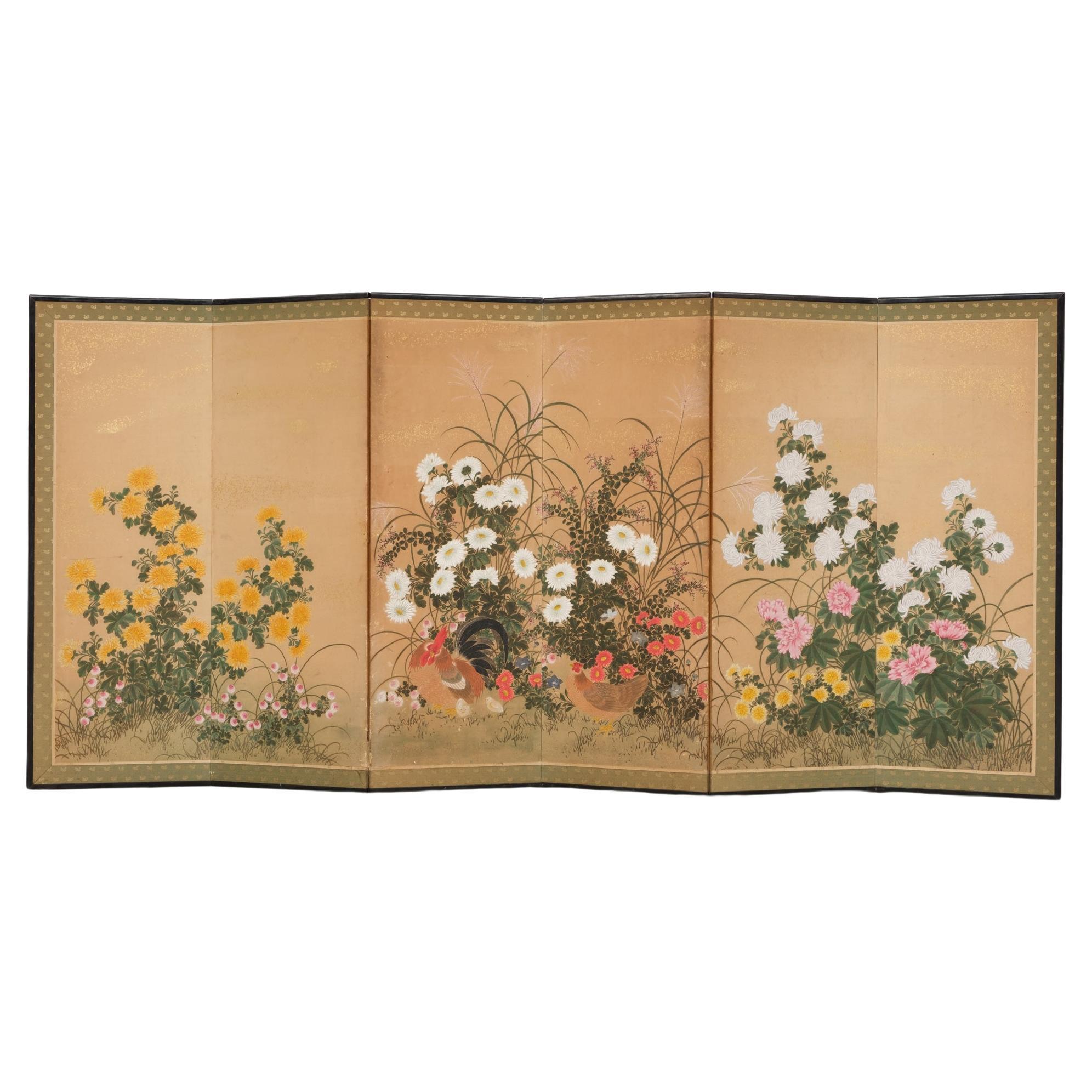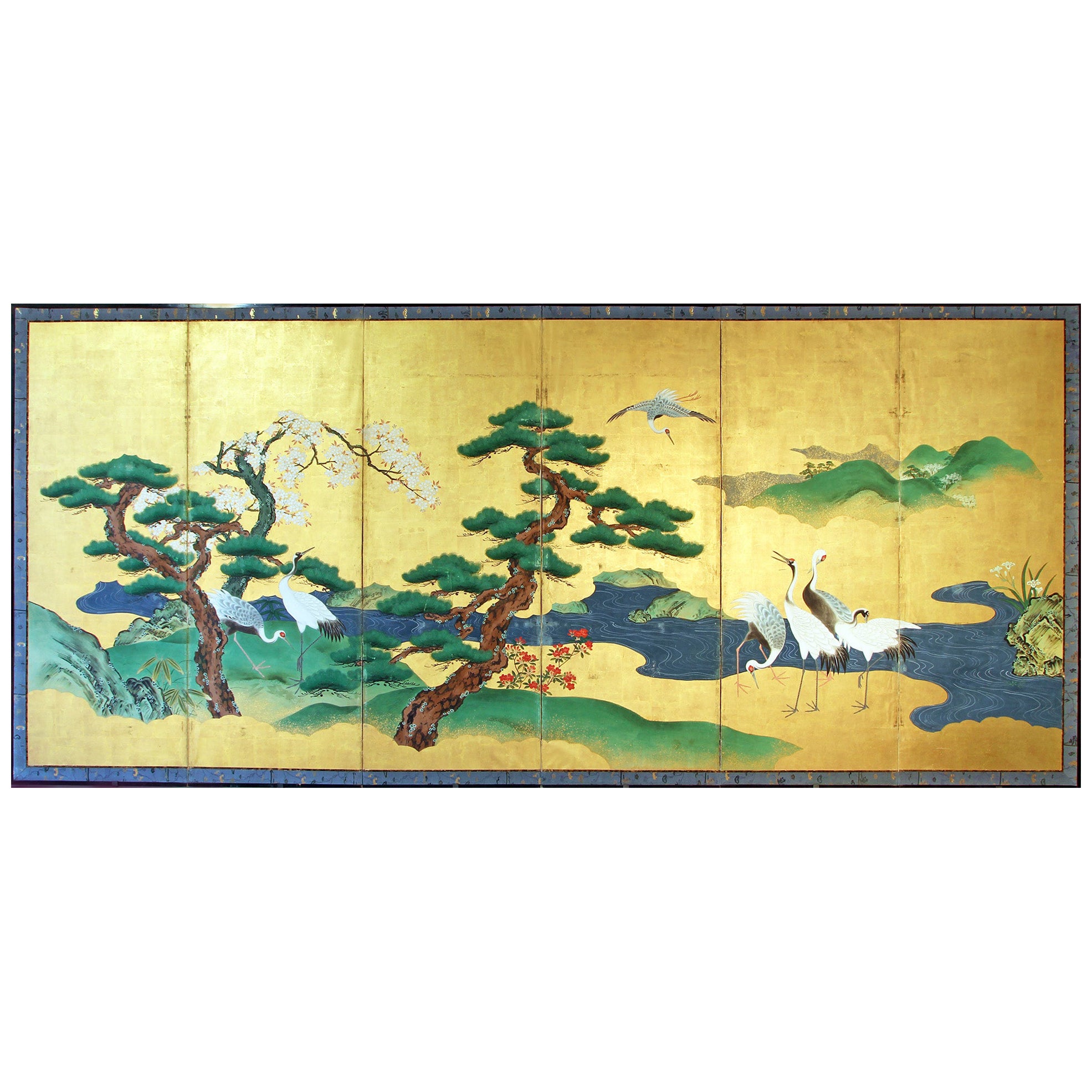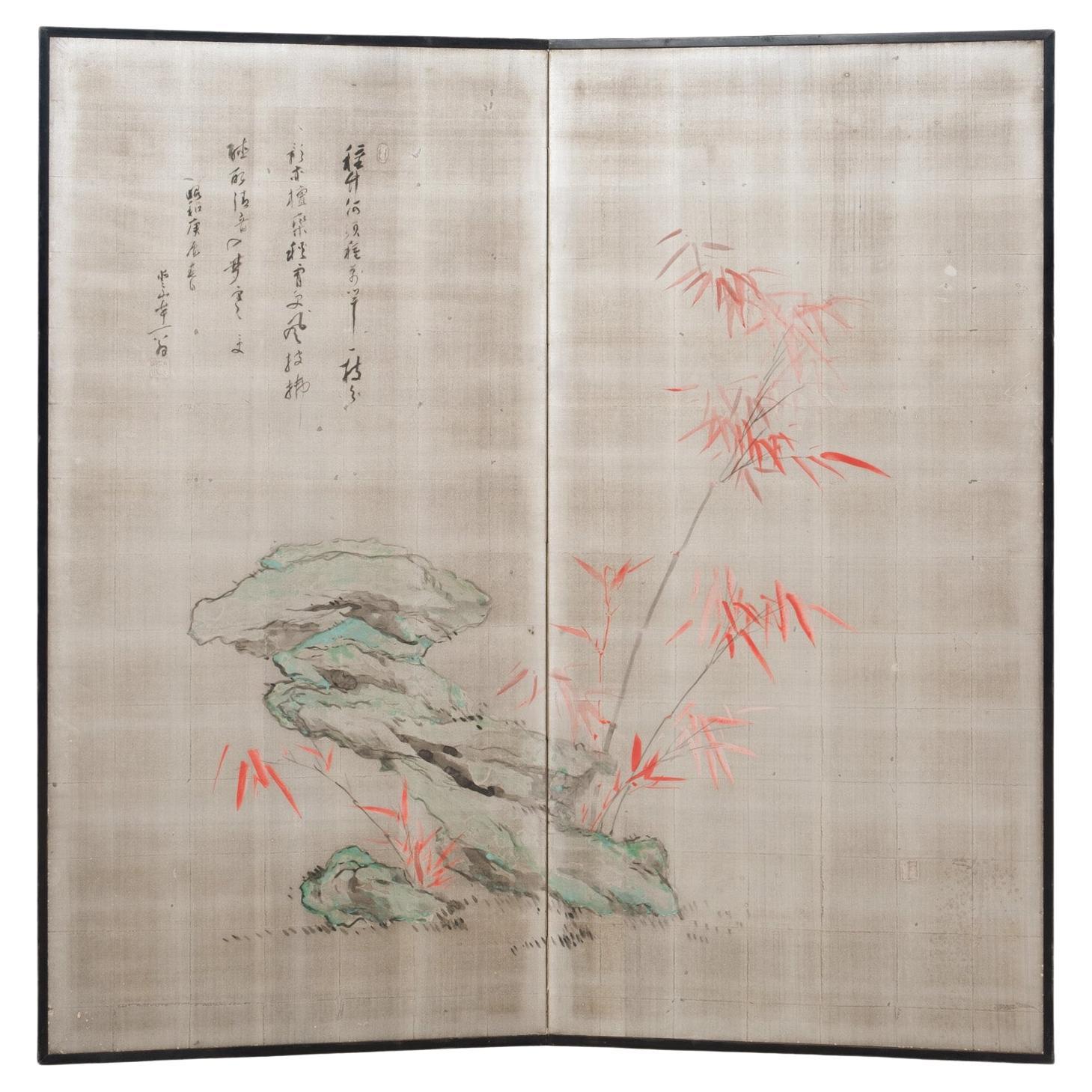Items Similar to Japanese 2-Panel Furosaki’byôbu 風炉先屏風 'Tea-Ceremony Folding Screen' with Dragons
Want more images or videos?
Request additional images or videos from the seller
1 of 11
Japanese 2-Panel Furosaki’byôbu 風炉先屏風 'Tea-Ceremony Folding Screen' with Dragons
About the Item
A striking low and wide two-panel furosaki’byôbu (tea-ceremony room divider) painted with two bright white dragons (ryû) flying amidst swirling black clouds. The left dragon holds a precious pearl (hôju) tightly in-between its claws, opening its mouth and sticking out its tongue a bit, while looking ferociously at the other dragon.
The ‘submissive’ dragon on the right has three-claws on each foot, which is commonly how dragons are depicted in Japan. However, if you look closely, you can see that the dragon on the left is painted with four-claws each. In Japan, it is believed that the more far-travelled a dragon is, the more toes it grows. Suggesting this dragon travelled all the way from China or Korea to Japan. Which also explains its position on the left screen, as it represents 'the West'.
This work is painted on paper, and protected by a wooden frame.
Likely signed 'Mika' and sealed 'Emika' by the artist in the lower left corner.
Dimensions:
Total width 73.07 in./185.6 cm (2 x 36.53 in./92.8 cm), Height 31.25 in./79.4 cm.
In Japan such screens are often used as a background for example vases with ikebana arrangements or other, in this case traditional tea ceremony objects. This screen is light in weight and can also be easily mounted flat on a wall and presented as one piece of art. Due to its smaller size, this screen fits perfectly in Western-style households.
When shipped we will add a certificate of authenticity.
- Dimensions:Height: 31.26 in (79.4 cm)Width: 73.08 in (185.6 cm)Depth: 0.67 in (1.7 cm)
- Materials and Techniques:
- Place of Origin:
- Period:
- Date of Manufacture:1912-1926
- Condition:Repaired: Two small restorations on the back. Wear consistent with age and use. It is in a very good condition with some minor traces of age and wear. Please look at the photos for a condition reference.
- Seller Location:Amsterdam, NL
- Reference Number:
About the Seller
5.0
Vetted Seller
These experienced sellers undergo a comprehensive evaluation by our team of in-house experts.
Established in 1996
1stDibs seller since 2022
16 sales on 1stDibs
Typical response time: 10 hours
- ShippingRetrieving quote...Ships From: Amsterdam, Netherlands
- Return PolicyA return for this item may be initiated within 14 days of delivery.
More From This SellerView All
- Japanese Mid-Size 6-Panel Byôbu 屏風 Screen with Chicken Family in a Flower FieldLocated in Amsterdam, NLA charming medium-size six-panel byôbu (folding screen) with a vibrant polychrome painting of a rooster with its family amidst a luscious flower garden. The garden is filled with al...Category
Early 20th Century Japanese Paintings and Screens
MaterialsSilk, Lacquer, Paper
- Large Japanese 6-panel byôbu 屏風 (folding screen) with chrysanthemum gardenLocated in Amsterdam, NLA very colourful and captivating large six-panel byôbu (folding screen) with a refined continuous painting of a luscious flower garden filled with many different types of chrysanthemums (kiku), next to a winding river. This multi-coloured painting is set on a shiny gold-leaf background, and the chrysanthemum flowers are painted by using shell paste (gofun) in low relief. Several clutches with a great variety of chrysanthemum flowers are in full bloom and they each show their unique form and colour. Varying from white, red, yellow and pink. The flowers bloom all around and on different kinds of bamboo fences and trellises. In Japan chrysanthemums are believed to represent happiness, love, longevity and joy. The panels are surrounded by two silk borders, a thin black one, and a wide brown one. The screen is protected by a black and red negoro’nuri...Category
Antique Late 19th Century Japanese Paintings and Screens
MaterialsGold Leaf
- Low Japanese 6-panel byôbu 屏風 (folding screen) with genre paintingLocated in Amsterdam, NLA nice, low, very decorative 6-panel byôbu (folding screen) features a continuous genre painting capturing various facets of daily life during the Edo period. It includes scenes such...Category
Antique Early 19th Century Japanese Paintings and Screens
MaterialsMetal, Gold Leaf
- Large Japanese 6-panel byôbu 屏風 (folding screen) with genre paintingLocated in Amsterdam, NLFascinating large six-panel byôbu (folding screen) with a detailed genre painting on goldish silver leaf with different scenes of people at work in a rural mountain village during th...Category
Early 20th Century Japanese Paintings and Screens
MaterialsSilver Leaf
- Large Japanese 2-Panel Byôbu 屏風 'Room Divider' with Painting of Bamboo & a PoemLocated in Amsterdam, NLBeautiful, large two-panel byôbu (room divider) with a serene painting of red-leaved bamboo and rocks on an oxidized silver leaf background. Silver leaf continuously undergoes the process of oxidation, which creates a beautiful aged patina. On the left an inscription from a ‘Zekku’ poem by the Chinese poet Yang Zai (1271?1323), titled: Shan shang zhu (bamboo (painted) on a fan). Translated as : Why would people plant a lot of bamboos? The shade of a single culm is also beautiful. In the autumn night it rocks on the wind, And the fresh sound echoes in my dream. Dated: Shôwa, the year kôshin (1938). Signature unknown...Category
Early 20th Century Japanese Paintings and Screens
MaterialsOther, Silver Leaf
- 260 Year Old Japanese Hanging Scroll with Painting of the 9-Headed Dragon DeityLocated in Amsterdam, NLAmazing 260 year old Japanese kakejiku (hanging scroll) with a refined painting of the nine headed dragon deity, with a Buddhist flame as a crown, an...Category
Antique Mid-18th Century Japanese Paintings and Screens
MaterialsMetal
You May Also Like
- Japanese Six-Panel Screen Byobu With Chrysanthemums And Autumn Grass and FlowerLocated in Torino, ITThe 19th Century Six-Panel Japanese folding screen "Byōbu" usually used in the most important Japanese house to stop wind and also to separate different space of the same big room de...Category
Antique Mid-19th Century Japanese Edo Paintings and Screens
MaterialsGold Leaf
- Japanese Two Panel Screen Dragon in the MistLocated in Hudson, NYInk (Sumi) on paper. Signature and Seal read: Kishi Ganku It is backed with paper covered in gold and silver flake. Kishi Ganku (1749 or 1756-1839) was the...Category
Antique Early 19th Century Japanese Edo Paintings and Screens
MaterialsWood, Paper
- Japanese Folding Screen Six Panels Painted on Gold LeafBy Japanese StudioLocated in Brescia, ITParavento a sei pannelli di scuola giapponese Kano: paesaggio con bellissime ed eleganti gru vicino al fiume, con alberi di pino e sakura. Dipinto a mano con pigmenti minerali ed inc...Category
Antique Early 19th Century Japanese Edo Paintings and Screens
MaterialsGold Leaf
- Japanese Four-Panel Folding Screen Byobu Signed Showa Period C.1950Located in London, GBA four-panel Japanese Byobu folding screen depicting a floral scene with birds. Japan, C.1950 Showa Period An attractive example, beautifully h...Category
Mid-20th Century Japanese Showa Paintings and Screens
MaterialsSilk, Paper
- 19th Century Japanese Screen for Tea-Ceremony, Ink Bamboo and Plum on Gold LeafLocated in Kyoto, JPThree Friends of Winter Nakajima Raisho (1796-1871) Late Edo period, circa 1850 Ink and gold leaf on paper. This is a double-sided Japanese Furosaki or tea-ceremony screen from the mid 19th century; bamboo and plum on the front, young pines the back. It by Nakajima Raisho, a master painter of the Maruyama school in the late Edo and early Meiji periods. In this work Raisho combines exquisite ink brushwork with large open spaces of brilliant gold-leaf to inspire the viewers imagination. Rather than naturalism, he is searching for the phycological impression of the motifs, resulting in abstraction and stylization. His simplification of the motifs the result of looking to capture the inner nature of the objects. This art motif is known as Sho Chiku Bai, or the Three Friends of Winter. Evergreen pine connotes steadfastness, bamboo suggests both strength and flexibility, while plum blossoms unfurling on snow-laden branches imply hardiness. Combined, this trio is emblematic of Japanese new year. Chinese literati were the first to group the three plants together due to their noble characteristics. Like these resilient plants flowering so beautifully in winter, it was expected of the scholar-gentleman to cultivate a strong character with which he would be able to show the same degree of perseverance and steadfastness even during times of adverse conditions. The screen would have been placed near the hearth of a room used for the Japanese tea ceremony, shielding the fire from draughts and also forming a stimulating and decorative backdrop behind the tea utensils. It would have been used in the Hatsugama, or first tea-ceremony of the new year. Nakajima Raisho (1796-1871) originally studied under Watanabe Nangaku before entering the school of Maruyama Ozui. He was the highest ranking Maruyama school painter at the end of the Edo period and was known as one of the ‘Four Heian Families’ along with Kishi...Category
Antique Mid-19th Century Japanese Edo Paintings and Screens
MaterialsGold Leaf
- Japanese Two Panel Screen, TurkeysLocated in Hudson, NYMineral pigments on silk, mounted on a gold panel, in silk border. Signature and seal read: Yoho.Category
Early 20th Century Japanese Paintings and Screens
MaterialsSilk
Recently Viewed
View AllMore Ways To Browse
Chinese Framed Panel
Japanese Painting Edo
Japanese Antique Framed
Edo Paint
Asian Black Screens
Japanese Silk Screen Painting
Japanese Gilt Wood
Chinese Painted Silk
Framed Chinese Screen
Japanese Brocade
Chinese Gilt Panel
Antique Japanese Panel
Framed Japanese Panel Painting
Japanese Leaf Screen
Japanese Silk Panel
Chinese Silk Painting
Chinese Silk Paintings
China Silk Painting





